A New Root-Knot Nematode species, Meloidogyne karsseni n. sp. (Nematoda: Meloidogynidae), From Mexico and a Taxonomic Update on M. paranaensis From Guatemala
- PMID: 37868786
- PMCID: PMC10590206
- DOI: 10.2478/jofnem-2023-0042
A New Root-Knot Nematode species, Meloidogyne karsseni n. sp. (Nematoda: Meloidogynidae), From Mexico and a Taxonomic Update on M. paranaensis From Guatemala
Abstract
A new root-knot nematode (RKN) species, Meloidogyne karsseni n. sp., associated with sweet pepper from Mexico, and a population of M. paranaensis from Guatemala, are described using data from morphological, biochemical (isozyme enzymes), molecular, and phylogenetic analyses. Meloidogyne karsseni n. sp. can be morphologically diagnosed using the combined features of the second-stage juveniles, viz. body length (345 to 422 μm), a conical rounded head region, a post-labial annule lacking transverse striation, a thin stylet 11 to 12 μm long, rounded to oval and backwardly sloping knobs, dorsal gland orifice (DGO) at 5.2 to 6.0 μm from the knobs, a hemizonid just above the secretory-excretory (SE) pore, a tapering tail with finely rounded terminus and one or two very weak constrictions at hyaline tail tip; the female characters viz. oval-to-rounded perineal pattern with coarse striation on lateral sides around the anus, low dorsal arch with finer striations, and distinctly visible lateral lines; and the male characteristics viz. a rounded and continuous head, a post-labial annule without transverse striations, a robust stylet 20 to 24 μm long, rounded-to-oval and slightly backwardly sloping knobs, and a DGO at 2.4 to 2.9 μm from the knobs. In all the studied males of M. paranaensis, a characteristic sclerotization around the duct of SE-pore was also observed for the first time. Sequences of 18S, D2-D3 of 28S, and ITS of rDNA, and cox1 of mtDNA were generated for the two species, and in the phylogenetic trees based on these genes, both species appeared in the tropical RKN species complex clade.
Keywords: Guatemala; Meloidogyne; Mexico; Root-knot nematode; new species; phylogeny; taxonomy.
© 2023 Phougeishangbam Rolish Singh et al., published by Sciendo.
Figures
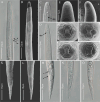
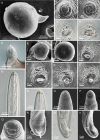
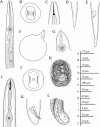
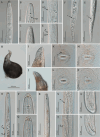


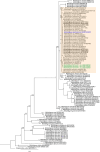
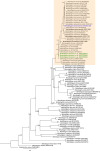

References
-
- Álvarez-Ortega S., Brito J. A., Subbotin S. A.. Multigene phylogeny of root-knot nematodes and molecular characterization of Meloidogyne nataliei Golden, Rose & Bird, 1981 (Nematoda: Tylenchida) Scientific Reports. 2019;9:11788. https://doi.org/10.1038/s41598-019-48195-0. - PMC - PubMed
-
- Bertrand B., Nunez C., Sarah J. L.. Disease complex in coffee involving Meloidogyne arabicida and Fusarium oxysporum. Plant Pathology. 2000;49(3):383–388. https://doi.org/10.1046/j.1365-3059.2000.00456.x.
-
- Bowles J., Blair D., McManus D. P.. Genetic variants within the genus Echinococcus identified by mitochondrial DNA sequencing. Molecular and Biochemical Parasitology. 1992;54(2):165–173. https://doi.org/10.1016/0166-6851(92)90109-w. - PubMed
-
- Bridge J., Starr J. L. Plant nematodes of agricultural importance: a color handbook. London, UK: Manson Publishing; 2007.
LinkOut - more resources
Full Text Sources
